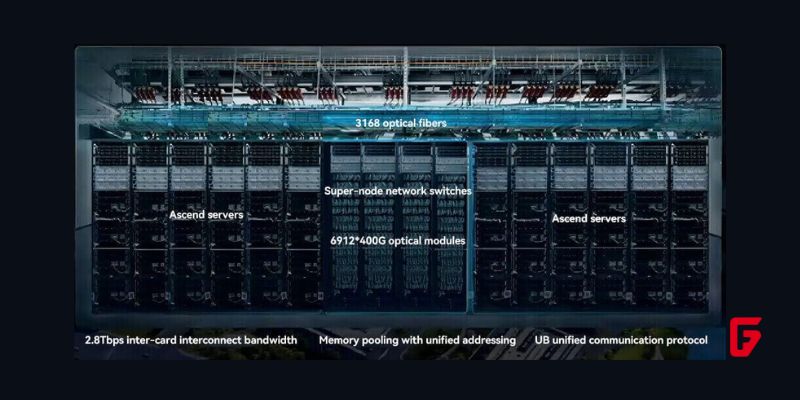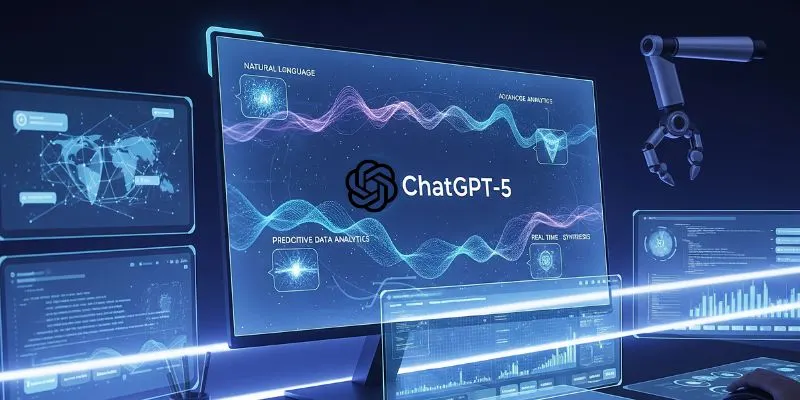Huawei CloudMatrix 384: China’s AI Supercomputer Takes On Nvidia
By futureTEKnow | Editorial Team

By futureTEKnow | Editorial Team

Huawei has officially unveiled its CloudMatrix 384 AI computing system at the World Artificial Intelligence Conference (WAIC) in Shanghai, seizing global attention as China’s most assertive leap toward challenging Nvidia’s AI dominance. This system, powered by 384 Ascend 910C chips, demonstrates Huawei’s audacious strategy to bridge the technology gap left by US export restrictions and marks a pivotal moment in the ongoing race to command the future of artificial intelligence in China.
Unlike its rivals, Huawei’s design philosophy prioritizes “system-level innovation” over sheer chip performance. While each Ascend 910C chip trails Nvidia’s top silicon in raw computational power, CloudMatrix 384 compensates by clustering hundreds of these chips in a unified, high-bandwidth network. The result? An estimated 300 petaFLOPS of performance—almost double Nvidia’s current GB200 NVL72 system.
“Supernode” architecture: Every chip links using an ultra-fast, all-to-all optical interconnect, slashing latency and boosting aggregate compute power.
Optical links: Photonic connections replace conventional copper, delivering both high speed and reliability across 16 system racks.
Operational in Huawei Cloud: Not just theory—CloudMatrix 384 is already running in production for cloud users, confirming practical viability for China’s AI sector.
The timing of this launch is no coincidence. Recent US bans on Nvidia’s most advanced AI chips, such as the H20, have opened a path for domestic Chinese players. Huawei has seized this vacuum, rapidly scaling Ascend chip production and pushing the CloudMatrix 384 into active deployment—even as debates continue over the future availability of Nvidia hardware in China.
Behind the scenes, Huawei pours roughly $25 billion annually into research and development. The company’s founder, Ren Zhengfei, openly acknowledges that Ascend chips “lag a generation behind” in physics but emphasizes “mathematics to complement physics” and the power of cluster computing over single-chip supremacy for real-world workloads.
There’s a catch. This brute-force approach is power-hungry—an estimated 559kW per system—which is more than twice the energy draw of Nvidia’s closest rival. Yet, with lower electricity costs and a political imperative for tech independence, China appears ready to bear these inefficiencies for the sake of autonomy.
The debut of CloudMatrix 384 doesn’t just represent a hardware achievement. It’s a clear statement: China now possesses an AI supercomputer able to rival Nvidia’s top-end tech by leveraging system integration and optical networking. Internationally, this escalates the tech rivalry as regulations tighten and Chinese firms build alliances to solidify a home-grown ecosystem
This is a milestone, not just for Huawei, but for the entire Chinese AI sector. By embracing a strategy of massive chip clustering and next-generation interconnects, Huawei has redefined the battle lines in the global AI hardware race. While challenges remain—especially around power consumption and software maturity—Huawei’s architecture innovation offers a credible path for technological self-sufficiency amid mounting geopolitical headwinds.

SpaceX aims to nearly double launches from Vandenberg in 2025, facing support from federal agencies but strong objections from the state and local communities.

Traditional Medicare will pilot AI-assisted prior authorization in 2026 across six states, focusing on high-risk outpatient services. Clinicians retain final say, but incentives and access concerns loom as CMS tests fraud reduction and “gold card” exemptions. Here’s what providers and patients should know.

OpenArt’s new “one-click story” compresses scripting, visuals, and edits into ready-to-post short videos—fueling viral growth and a fresh IP debate. We break down how it works, adoption signals, what’s next (multi-character, mobile), and practical guardrails creators and brands should follow to stay original and compliant.

OpenAI’s o3 swept the Kaggle AI chess tournament, defeating xAI’s Grok 4–0. The victory fueled the intense rivalry between Altman and Musk, reshaping AI benchmarks.

NASA and Google’s AI-powered Crew Medical Officer Digital Assistant enables autonomous diagnoses for astronauts on Mars missions, redefining remote healthcare for space and Earth.

Pinterest’s CEO confirms that fully agentic AI shopping is years away, as the platform invests in AI-powered tools to enhance discovery, inspiration, and personalized shopping experiences for millions.

Shopify’s new AI shopping tools are transforming e-commerce, letting agents and chatbots deliver smooth, personalized shopping and checkout experiences across platforms. Learn how these innovations reshape online retail.

Meta has acquired WaveForms AI, a startup pioneering emotion-detecting voice technology. Learn what this means for Meta’s AI voice ambitions and the future of AI audio.

Tracelight is revolutionizing financial modelling for finance professionals with AI-powered Excel tools that automate complex tasks, reduce errors, and unlock new analysis capabilities. Learn how this next-gen solution changes the future of spreadsheets.

China’s Lanyue lander completed its first major test, showcasing advanced engineering for safe, crewed moon landings before 2030. Explore how this milestone shapes the space race.

Microsoft rolls out GPT-5 across its Copilot suite, integrating smarter AI for enterprise and personal users. Discover new features, free access, and what sets this launch apart.

OpenAI’s GPT-5 is now live for all ChatGPT users. It brings faster, smarter AI with improved reasoning, expanded context, and safer outputs—marking a major leap in generative technology.
To provide the best experiences, we use technologies like cookies to store and/or access device information. Consenting to these technologies will allow us to process data such as browsing behavior or unique IDs on this site. Thanks for visiting futureTEKnow.